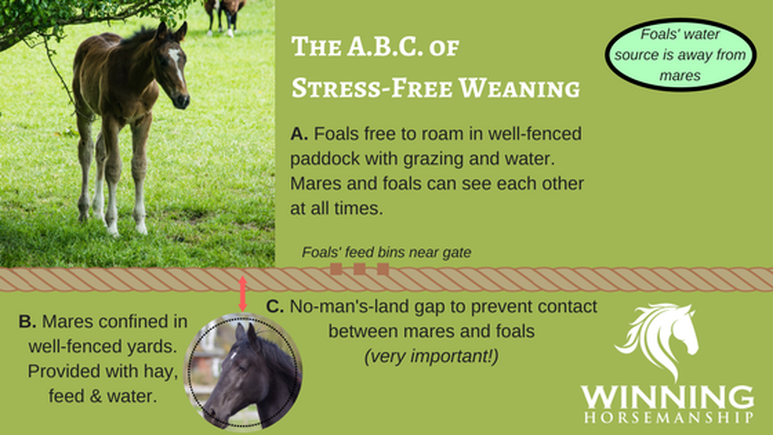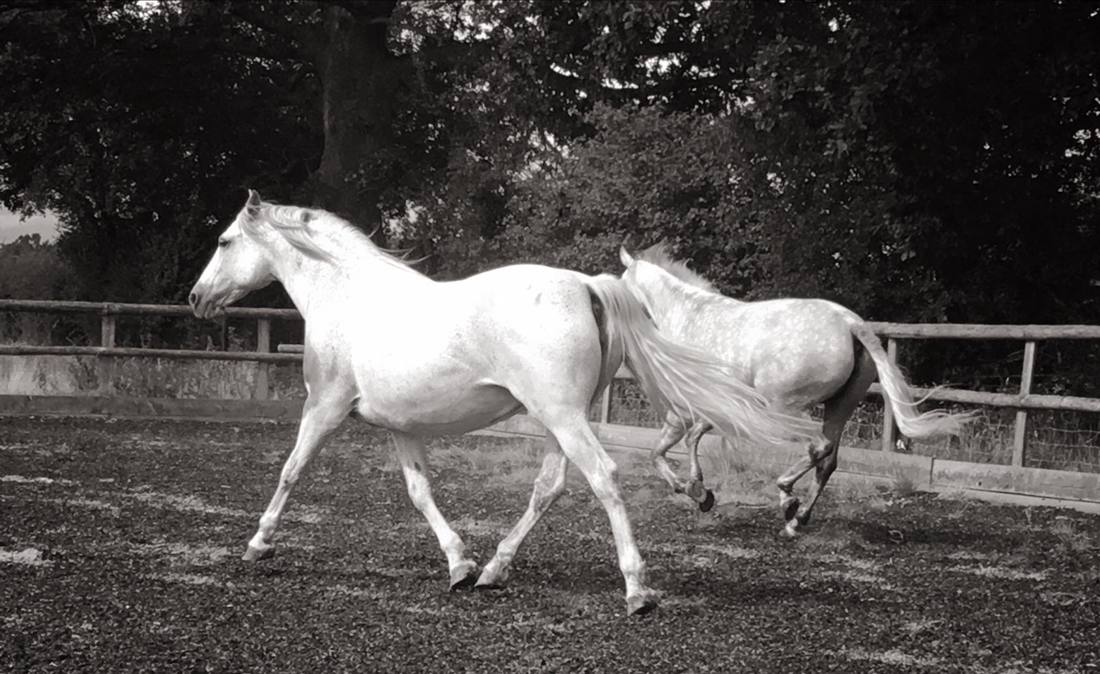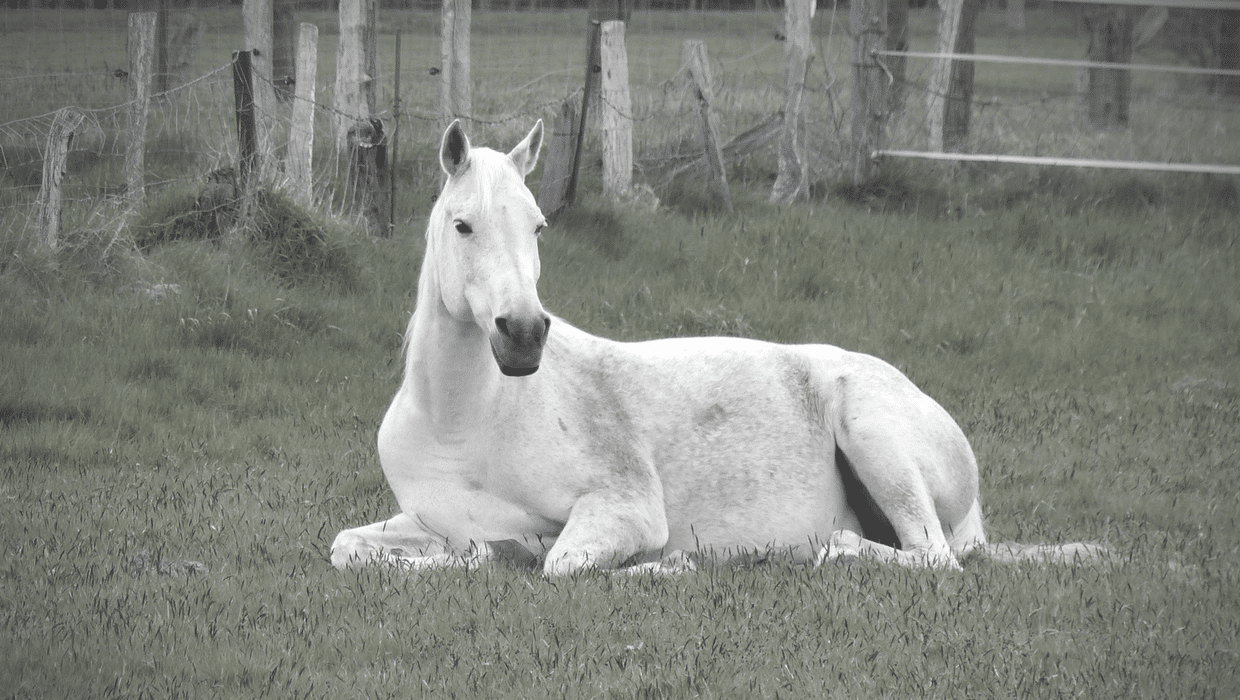|
A question that I get asked a lot, especially by first time breeders, is what is the best way to wean a foal?
There are many ways of achieving this objective, but the winning horsemanship way of weaning aims to provide the safest, kindest, least stressful experience for all concerned: mare, foal and owner! At the Highborn Warmblood Stud, I designed my yards and paddocks to facilitate peaceful weaning (see illustration above). You may not have the facilities that I set up, but if you have good fences and adhere to the basic principles outlined in this post, all should go according to plan. I usually weaned several foals at once, which gave both mothers and babies the benefit of companionship. However, the following weaning procedure will work just as well for one foal. My tried and tested method, refined over 16 years, is to enclose the mare in a yard. Enclose the foal in an adjacent paddock. Make sure there is a bit of "no-man's-land" between mare and foal, so there is no opportunity for physical contact between them. A couple of metres is good. Don't make the gap so wide that the foal feels the need to try to jump the fence to get back together. We want to maintain the idea of togetherness, even though they can no longer touch. The physical separation helps to speed the process but it is also an important safety precaution. If there is a way to nurse between wires or rails, your foal will find it and your mare will make herself available. Foals are very ingenious - but not very experienced - and you don't want your precious progeny hung up in a fence, so provide a suitable gap. Arrange things so the mare doesn't have to go anywhere for food and water, but the foal is obliged to move away from the mare to eat, graze and drink. This way, the foal always has the security of knowing where Mum is, but learns to be increasingly independent. Any time they find themselves too far away, all they have to do is run back. Similarly, Mum can see the foal at all times so everyone is (relatively) happy. Moving away from the mare becomes the foal's idea. I found that this simple habit of autonomy can help young horses to avoid separation anxiety and other herd-bound behaviour in later life. Occasional episodes of getting out of the comfort zone with lots of whinnying and zooming around are to be expected, but will decrease every day and eventually cease altogether. It really helps if you can wean two or more foals together (having more than one mare in the yards provides company and moral support for the mothers too). If that isn't possible, then another quiet horse (or even a sheep, goat or cow), introduced to the family group well before weaning time, will provide company for junior as he or she moves further afield and stays away longer. About a week's separation should do the trick, but it's best not to reunite mare and foal for several months afterwards as some mares will welcome baby back in a flash! There are two sides to the weaning story: both mare and foal. Having the mare in a yard being hand fed allows you to monitor her for undue discomfort. It is natural for her udder to get distended and possibly even to run milk. It is no fun whatsoever for the mare, but the lack of a suckling stimulus will lead to her drying up naturally. Many mares rather welcome the end of providing milk on demand and shut down production quite quickly, but some are tremendous milkers. For the latter group, you may need to gently (and carefully) milk her a little, once or twice a day, to relieve the pressure a bit, but only on the first couple of days. I have personally never had to deal with a case of mastitis but if you suspect your mare is in trouble, then call your veterinarian immediately to discuss. Good luck with your foal's rite of passage! If you found this post helpful, please share with your friends. Got some weaning suggestions, tips, stories or questions? Please leave a comment below! For more information about raising and training your young horse, read Winning Horsemanship by Joanne Verikios. Read Kharon's story at the end of the article. Trust ...
How do we come to TRUST our horses and each other? Well ... we start by listening ... this listening forms an understanding ... a way to read the “whys” behind how we are wired to feel or react to each other, both in horses and ourselves. We can mould to use just enough energy to express our points of view without going into confusion, fear or dominance ... by us listening. This listening establishes our needs and those needs of our horses to be heard ... we call this our boundaries. Few humans understand that relief It is a cold day again. Cold enough that the windscreen of the old F100 is iced over and must be defrosted with a saucepan of warm water, combined with fast action on the windscreen wipers. The frost doesn't reach all the way to the top of the gum trees, but it is fat and furry on the strands of fencing wire, which look like thick white cords in the mist.
I have already done the rounds of my horses, checking and feeding the mares and youngsters; riding Powerlifter, my stallion, grooming him dry, mucking out his stable and letting him go in his paddock. A quick shower, a bit of makeup, a change of clothes and I'm ready for my 45 minute drive to work. The cabin of the truck feels freezing cold and the heater will take a while to kick in. Never mind, I'm used to it and I'm wearing a nice overcoat. Soon there will be equilibrium and I'll stop shivering. Down the driveway, ford the creek, out the gate and I'm off our property. The low, concrete causeway across the Molonglo River leaves only the width of a tyre to spare on each side and always commands a bit of respect. Today the river is white and frothing - no chance of spotting the trout I have sometimes seen hovering in there on sunny days. I'm about fifteen minutes into my commute towards Queanbeyan and thence on to Canberra, when I see something wrong out of the corner of my eye. Something about a horse in a paddock to the right. What is it? I brake, back up, take a better look. |
From a very early age I have been able to tune in to what horses and ponies were thinking and what they were likely to do next.
Archives
September 2020
Categories
All
|





 RSS Feed
RSS Feed